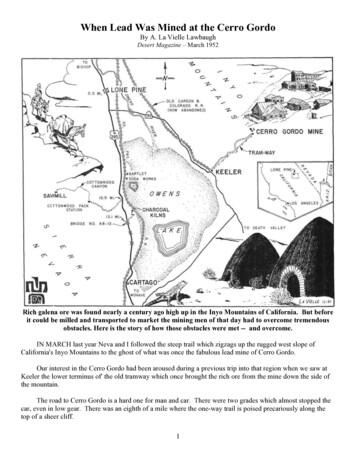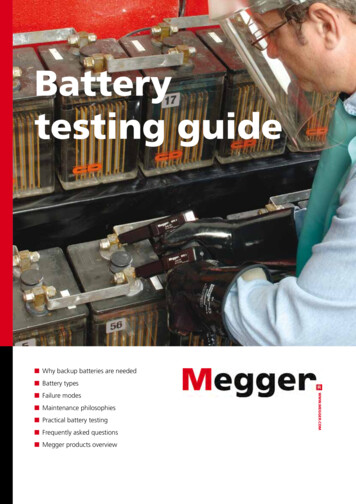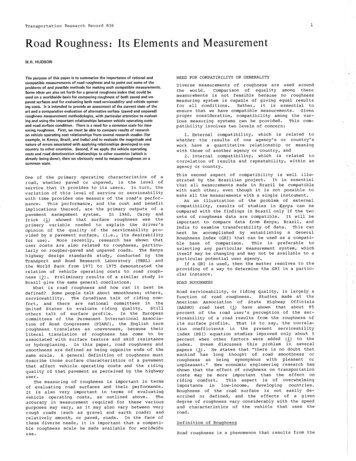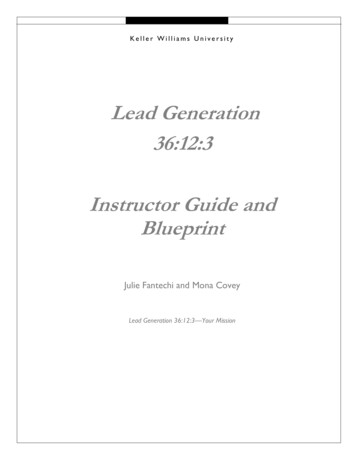
Transcription
When Lead Was Mined at the Cerro GordoBy A. La Vielle LawbaughDesert Magazine – March 1952Rich galena ore was found nearly a century ago high up in the Inyo Mountains of California. But beforeit could be milled and transported to market the mining men of that day had to overcome tremendousobstacles. Here is the story of how those obstacles were met -- and overcome.IN MARCH last year Neva and I followed the steep trail which zigzags up the rugged west slope ofCalifornia's Inyo Mountains to the ghost of what was once the fabulous lead mine of Cerro Gordo.Our interest in the Cerro Gordo had been aroused during a previous trip into that region when we saw atKeeler the lower terminus of' the old tramway which once brought the rich ore from the mine down the side ofthe mountain.The road to Cerro Gordo is a hard one for man and car. There were two grades which almost stopped thecar, even in low gear. There was an eighth of a mile where the one-way trail is poised precariously along thetop of a sheer cliff.1
When Lead Was Mined at Cerro GordoAnd when finally we reached the mine welearned that our quest for the complete story ofCerro Gordo had only begun. Before the story wasall recorded in our note books we had searchedOwens Lake for rotting steamboats, the shore linesfor charcoal kilns -- and then a 6,000-foot climb tosearch out an old sawmill high in the mountainrange which rims Owens Valley.The mine is on the western slope near thesummit of the Inyo Range. The “fat hill” -- CerroGordo, in Spanish -- is a distinctive landmark justto the north of the mine. A Mexican, Pablo Flores,and two companions first discovered the richoutcrops in the 1860's. The ore occurred aslenticular masses of massive cerussite, 5 or 6 feetacross, in the limestone. These masses wereconcentrically banded and usually contained a smallcore of unaltered galena. To smelt this rich ore,Flores employed vesos, which were crude rockfurnaces. As in the case of all bonanza strikes,word leaked out and soon the Mexicans hadcompany and before long were shunted aside. Therush was on. Claims were staked, bought and sold,and blood was spilled. Almost overnight, CerroGordo boasted a population of 700 and within a fewyears had climbed to over 2000! Buildingsmushroomed, despite the high cost of lumber.Gambling and dance hall girls provided the lustynight life portrayed in western movies.Today, only a few buildings are clustered onthe steep slopes. We pulled our over-worked car toa halt in front of the building which formerly servedas a recreation room for the miners. Most of thefurnishings are gone, but the overhead wires, withcounter heads for snooker pool arc still there. Thecaretaker greeted us hospitably and gave us waterfor the car and coffee for our own refreshment.Top: These adobe kilns were built to make charcoalfor the old Cerro Gordo mine.Center: All that remains of the saw mill from whichcame Cerro Gordo's lumber and charcoal.Bottom: Neva Lawbaugh rests on the tongue of oneof the ancient logging wagons high up in HorseshoeMeadow.We learned that the present owners of themine employ a crew of 12 in an effort to locate anelusive rich vein. Sons of the owners, StevenWasserman and Christopher Reynolds, were thetwo unfortunate lads who later in the year lost theirlives trying to scale the treacherous cast face of Mt. Whitney. Our host told us of handmade digging tools,2
When Lead Was Mined at Cerro Gordorelics of another day, which had been found in the 27 miles of underground tunnels and slopes. Some of thelevels go down to 900 feet. We saw an old candle end of sheep's tallow which had come from a ledge far belowthe surface.The building which houses the mine end of the tramway is still standing. This spectacular ore conveyorwas built in 1911 by Louis D. Gordon who found large deposits of zinc which earlier miners had ignored intheir quest for silver. The tram is about six miles long and is said to have cost 250,000. It is operated bygravity, with ore buckets hanging from steel cables. As the loaded buckets dropped down to Keeler, theempties were drawn back up to the mine. A huge brake wheel is at the mine terminal of the tramway.The steep slopes around the mine are dotted with little leveled plots where houses once stood. Foundationrocks, old iron bedsteads and scraps of weathered wood are all that remain. For more than an hour we walkedthe indistinct old streets and footpaths of Cerro Gordo. A mile distant, at the old Chinese cemetery, we recalledthe China Stope incident. A Chinese crew was working below the 200 foot level, when a cave-in buried anumber of them alive. They had neglected to timber-up properly.There are structures still standing at the mine which ante-date the Gordon era. A tall chimney affair builtof native stone attracted our attention. Upon examination, it proved to be a smelter. Our host told us that it wasone of those built by M. W. Belshaw who was one of the first white men to move in after the discovery by theMexicans. A silver smelter required charcoal in those days and lots of it. Neva and I had seen where manybuildings had stood but didn't give much thought to the wood from which they had been constructed. Now herewas a place which had consumed prodigious amounts of charcoal. Charcoal must be reduced from wood inspecial ovens or kilns. Where did the old miners get their wood, their lumber? In all the Inyos there is nothinglarger than scrub growth, for they are a desert mountain range. The caretaker could not answer the question, buttold us of some old timers at Keeler and Cartago who might know the answer.The eight-mile drive back to Keeler was in sharp contrast to the difficult struggle up the grade. Twilightwas approaching. The dry bed of Owens Lake seemed to cover the whole valley floor. At one place, where thetram soars high above the road, we paused to watch a bighorn sheep. He was high on the ridge next to the outstretched stanchions which bold the tram cables. I focused the field glasses on him and he was watching us.After a minute, he casually turned and dropped from sight beyond the ridge. We camped on a bench aboveKeeler and enjoyed to the fullest a cool, quiet desert night and gazed at at least a million more stars than weever see when at home in Los Angeles.The next day was full of surprises. In running down the origin of the timber which had been used forcharcoal production and lumber we talked to several of the older residents of Keeler. The first woman wequestioned wasn't sure about the timber but was eager to tell us about the steamboats! There actually weresteamboats which sailed the coffee-colored water of Owens Lake's nearly saturated solution of salt and alkali!Belshaw's outfit which operated the Union Mine at Cerro Gordo was producing so many 80-pound bullion bars,shaped like loaves of bread, that they began to pile up. To speed their shipment, the Bessie Brady and theMollie Stevens were built to haul the bullion from Keeler across the lake to Cartago. The steamers wereshallow draft, clam-shell bottom, ferry-type boats. They lugged tons daily and still the stacks of silver mounted.Late-comers, beset by the shortage of living quarters resided for a time in hutches made by stacking the ingotsas walls and covering over the top with canvas or boards. On return trips the boats carried equipment, charcoaland lumber from the west shore of Owens Lake.3
When Lead Was Mined at Cerro GordoThe old east shore landing which the steamers used is about half a mile north of Keeler. We searched allthe day for evidence of old hulls, boilers, anything which might prove the story. One old-timer led us to a spoton the north shore where the Bessie had grounded after a hard blow on the lake. We found nothing but driftedsand, a horned toad, two leopard lizards and lots of creosote bushes. Another informant, William Isbester,recalls that when he first visited Keeler, the Bessie Brady was a burned out hulk, still at the old wharf. This oldship was launched in 1872, was 85 feet long, 16 feet in beam and powered by a 20-horsepower engine. Her costwas reputed to be 10,000. Records show that Belshaw also was in the steamer business for he launched theMollie Stevens in 1877. Her engine was supposed to have come from the U.S.S. Pensacola. Since our search, aLone Pine lad found one of the old anchors. It was hand-forged, about five feet long and weighed 400 pounds.Further excavation is planned for the recovery of other parts of the old steamer. This digging may be donewith enthusiasm for one of the boats was reported to have sunk with a load of bullion aboard.The next day on the west shore of the lake we found the old bee-hive shaped charcoal kilns. Theenterprising Belshaw also built the kilns. F ire brick was hauled in and laid. The exterior was covered withadobe, which during the ensuing years has eroded away. There are two or them, each about 20 feet high and 20feet in diameter. We discovered them after some difficulty, for their adobe finish came from the very groundupon which they stand. A perfect camouflage. As I stooped to go inside one of the kilns, a gridiron-ladedlizard darted from its sunning position in the entrance-way.4
When Lead Was Mined at Cerro GordoWhile sitting on the slope of the ridge behind the kilns we saw a most curious thing. Neva was first awareof it and quietly motioned to me. Two gridiron-tailed lizards were moving back and forth towards each other ina graceful circling motion. It must have been a sort of courtship, for they continued the odd dance for sometime, back and forth with a weird rhythm. They scampered swiftly lo cover when a red-tailed hawk swoopedlow overhead.The cord wood which went into the kilns, and the lumber used for construction came from high up inCottonwood Canyon. A sawmill was built at the east end of' Horseshoe Meadows at the 10,000 foot level.Beams as large as 4 x 12 inches and cord wood of varying sizes were cut and dropped into a flume for the riproaring ride to the edge of Owens Lake, 14 miles away.Dusk found us al Leo Rogers' pack station in Cottonwood Canyon. Water flows down the canyon until itis lost in the desert sands. We camped by the little stream that night, after arranging for two horses for themorrow's climb. The raucous cries of blue-jays awakened us. By the time we had breakfast and cleaned upcamp, Leo was there with the horses. The climb from the pack station to the mill is about 6,000 feet. Along theway we saw remnants of' the old flume. It was a V-shaped trough, with sides about two feet high.I had expected to find some timber at the mill site. Actually, the logging was done three miles further upthe canyon. A stream which flowed down the canyon had been dammed and a 30-inch pipe from the headstockunder a 20-foot pressure head furnished power to drive the large circular saw. One of the old logging wagonsstood near the mill -- a ponderous affair with thick, cross-cut sections of logs for wheels.Our story was now complete. We had explored the desert floor and the mountain rims to verify the factsabout a highly productive mining venture of nearly a century ago. The Cerro Gordo is said to have producedmillions in lead and silver and zinc -- but back of that fortune were stalwart men who overcame tremendousobstacles to mine and market the ores which nature had created there.View down the Yellow Grade Road on the way to Cerro Gordo. Photo courtesy of Ray DeLea 20165
Mollie Stevens were built to haul the bullion from Keeler across the lake to Cartago. The steamers were shallow draft, clam-shell bottom, ferry-type boats. They lugged tons daily and still the stacks of silver mounted. Late-comers, beset by the shortage of living quarters resided for a tim










